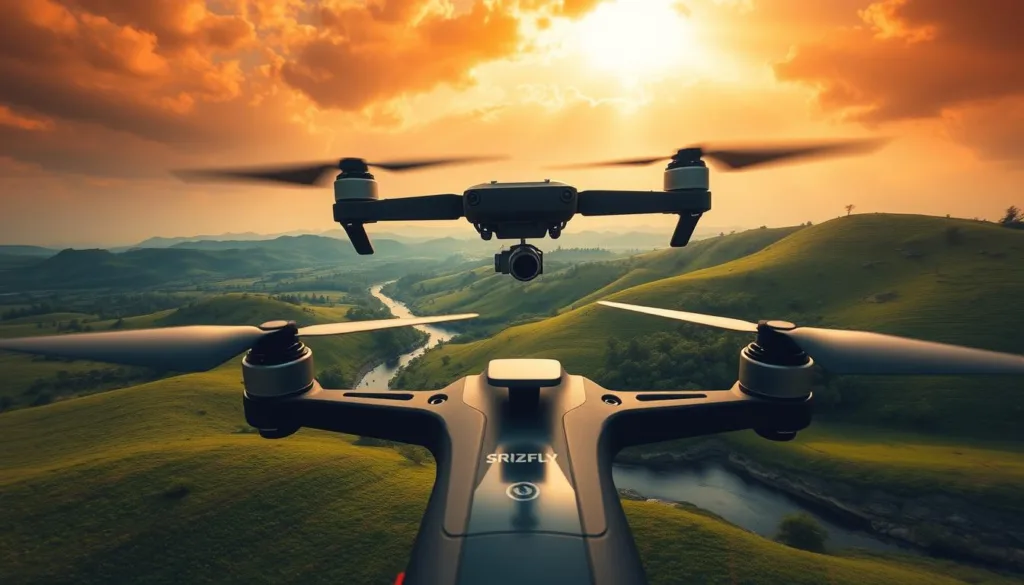For enthusiasts of FPV drone flying, honing piloting skills without risking damage to the aircraft or surroundings is crucial. A quality FPV simulator provides an ideal solution, offering a realistic and safe environment to practice and improve flying techniques.
With numerous simulators available, selecting the right one can be challenging. This article explores how free FPV simulators can provide an accessible entry point for both beginners and experienced pilots, allowing them to practice without a significant financial investment.
Developing crucial flying skills without risking expensive drone equipment is a significant advantage. The physics engines behind these simulators replicate real-world flying experiences, making them invaluable tools for pilots.
Key Takeaways
- Explore the landscape of free FPV simulators available in 2023.
- Understand how these simulators can help develop crucial flying skills.
- Learn about the physics engines and their replication of real-world experiences.
- Get practical guidance on choosing the right simulator based on specific needs.
- Compare free options against paid alternatives to determine the best fit.
Why FPV Simulators Are Essential for Drone Pilots
With the rise of drone racing, FPV simulators have emerged as an essential training tool. These simulators provide a realistic and immersive experience, allowing pilots to hone their skills without the risk of damaging their drones.
Saving Money on Crashes and Repairs
One of the primary benefits of using an FPV simulator is the cost savings. Crashes are an inevitable part of learning to fly a drone, but with a simulator, pilots can crash without incurring expensive repair costs. This makes FPV simulators ideal for beginners who are still learning the basics.
Building Muscle Memory Before Real Flights
FPV simulators allow pilots to develop crucial muscle memory for stick movements and control inputs. This muscle memory directly transfers to real-world flying experiences, making pilots more confident and competent when they transition to actual drones.
Practicing in All Weather Conditions
Simulators provide consistent practice opportunities regardless of weather conditions. Pilots can maintain and improve their skills even during winter months or rainy seasons, ensuring they stay proficient year-round. For racing enthusiasts, simulators offer a consequence-free environment to practice high-speed maneuvers and competitive techniques.
Understanding FPV Simulators: The Basics
FPV simulators have become an essential tool for drone enthusiasts, offering a safe and cost-effective way to practice flying skills. These simulators provide a realistic environment where pilots can improve their techniques without the risk of crashing their drones.
How FPV Simulators Work
FPV simulators utilize sophisticated physics engines to replicate the flight characteristics of drones, taking into account factors such as weight, thrust, drag, and momentum. This technology allows pilots to experience a realistic flying experience, closely mimicking the actual handling of FPV drone equipment. Most simulators can be connected to real radio controllers via USB, creating a hardware setup that closely resembles the actual flying experience. As “FPV drone simulators are invaluable for training pilots”, they have become a staple in the drone flying community.
Simulator vs. Real-World Flying Experience
While FPV simulators have become increasingly realistic, they still differ from real-world flying in subtle ways, particularly in terms of environmental factors like wind and air pressure. However, modern FPV drone simulators incorporate realistic physics models based on actual flight data, making them valuable training tools for pilots at all skill levels. Understanding the limitations of simulators helps pilots better translate their virtual skills to real-world flying scenarios. As the technology behind these programs continues to evolve, newer simulators offer increasingly accurate representations of actual flight dynamics.
By practicing with FPV simulators, pilots can develop the skills needed to navigate complex flying scenarios, ultimately enhancing their real-world flying experience.
What Makes a Good FPV Simulator?
The key to improving your drone flying skills lies in a high-quality FPV simulator. A good simulator provides a realistic and immersive experience, allowing pilots to practice and hone their skills without risking damage to their equipment.
Physics Realism
Nailing lifelike drone physics is crucial for skills that translate from the simulator to real-world flying. Realistic physics engines account for factors like prop wash, momentum, and gravity effects, making the simulation more authentic. As “the quality of physics modeling is perhaps the most critical aspect of any FPV simulator”, it’s essential to choose a simulator that offers accurate physics simulation.
Graphics Quality and Performance
While impressive graphics enhance immersion, performance is more important. A simulator must maintain high frame rates to provide the responsive feedback necessary for skill development. 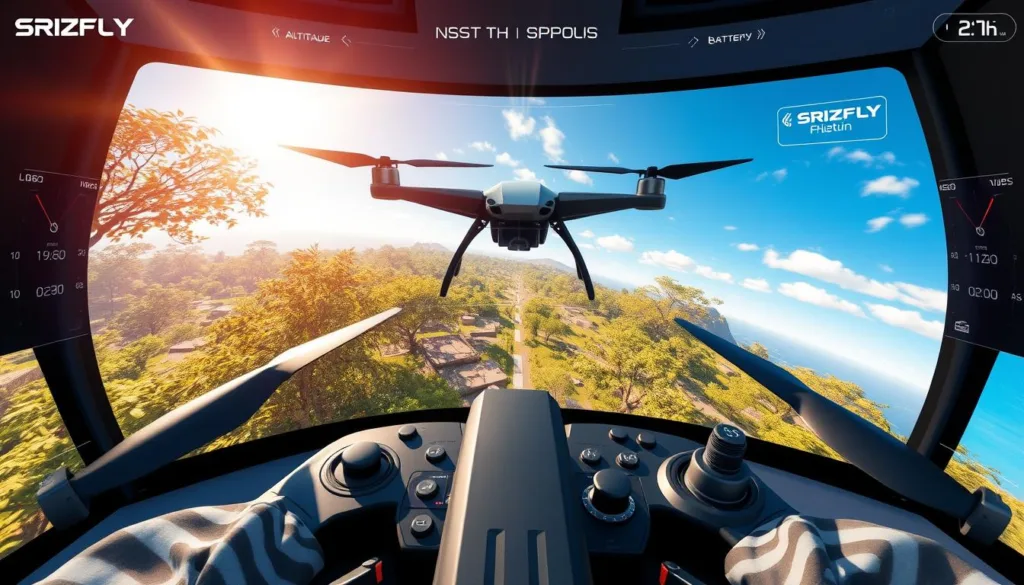 According to experts, “a good FPV simulator should have a balance between graphics quality and performance.”
According to experts, “a good FPV simulator should have a balance between graphics quality and performance.”
Customization Options
Customization options allow pilots to adjust their virtual drones to match the specifications and flight characteristics of their real equipment. This includes adjusting rates, PIDs, and other flight parameters to create a more authentic experience. The best simulators offer extensive freestyle possibilities with varied environments that challenge pilots to develop creative flying techniques.
By considering these factors, drone pilots can choose an FPV simulator that meets their needs and helps them improve their skills. Whether you’re a beginner or an experienced pilot, a good FPV simulator is an essential tool for taking your flying to the next level.
Connecting Your Radio Controller to Simulators
The key to realistic FPV simulation lies in using a proper radio controller. Unlike a gaming controller or keyboard, a radio helps build the muscle memory you’ll need when flying a real FPV drone.
Compatible Radio Controllers
Most modern radio controllers can connect to computers via USB, either directly or through adapter cables, allowing them to function as input devices for simulators. Popular brands like FrSky, RadioMaster, Jumper, and TBS typically offer good compatibility with most simulator software on the market.
Using your actual FPV radio controller with simulators creates muscle memory that directly transfers to real-world flying, making it vastly superior to keyboard or gamepad controls.
Setting Up USB Connections
The setup process usually involves installing drivers, calibrating sticks, and configuring button mappings within the simulator software. For controllers without direct USB connectivity, simulator dongles are available that allow wireless connection to your computer.
Most free simulators provide detailed guides for connecting various popular radio controllers to their software, ensuring a smooth setup process.
Best Free FPV Simulators in 2023
Free FPV simulators are a game-changer for drone enthusiasts on a budget. They offer a risk-free environment to hone skills without the financial burden of purchasing a drone or risking damage to a real drone. In this section, we’ll explore two of the best free FPV simulators available in 2023: FPV.SkyDive and Tiny Whoop GO.
FPV.SkyDive
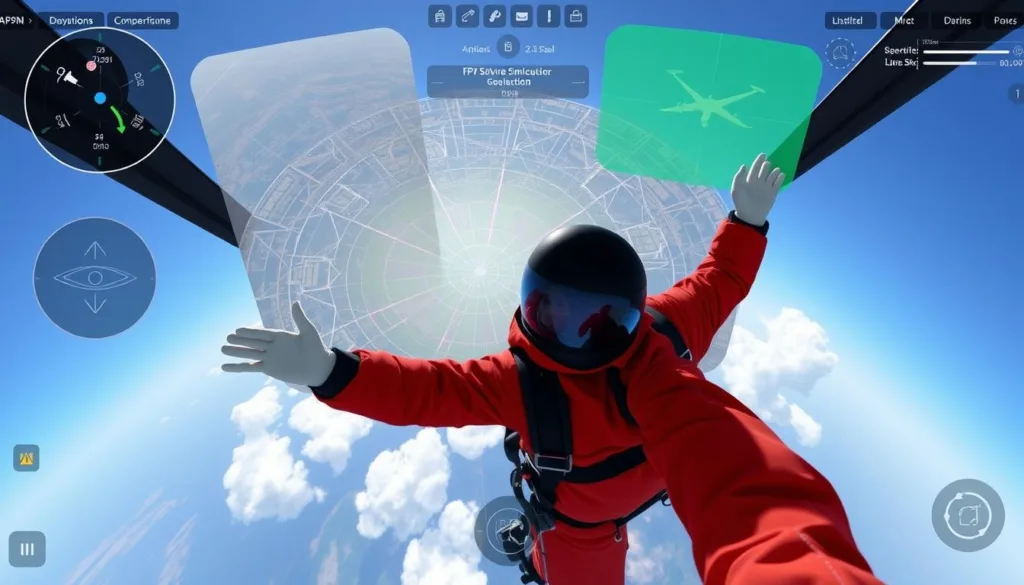
Overview
FPV.SkyDive, developed by ORQA, INC, is considered one of the best free FPV simulators available. It offers a realistic flying experience with various features that cater to both beginners and experienced pilots.
Features
Some of the key features of FPV.SkyDive include five practice levels ranging from beginner to expert, options for camera drones, racing drones, and freestyle quads, controller and radio input support, multiplayer mode (local only), and a track editor. It’s also compatible with VR headsets.
Pros
Realistic Physics: FPV.SkyDive offers surprisingly realistic physics, making it an excellent tool for learning. Variety of Drone Options: It supports various drone types, including racing quads and freestyle drones, allowing pilots to adjust flight characteristics.
Cons
While FPV.SkyDive is feature-rich, it may lack some of the polish found in paid simulators. However, it remains an excellent free option for those looking to improve their FPV skills.
Tiny Whoop GO
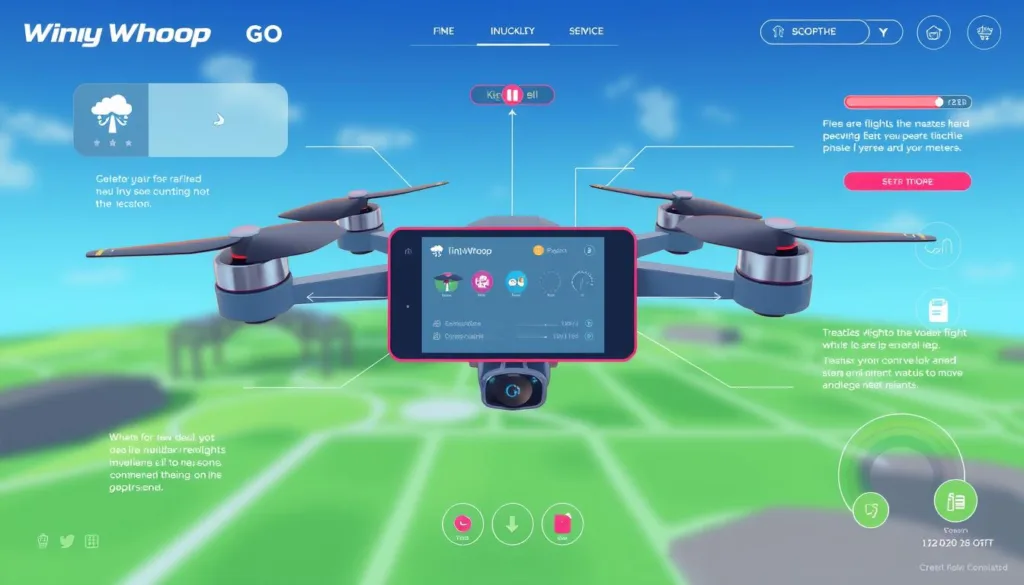
Overview
Tiny Whoop GO is a free FPV simulator that focuses specifically on micro drone simulation. It’s an excellent choice for those interested in Tiny Whoop racing.
Features
Tiny Whoop GO features accurate flight physics and prop wash, single-player time trials, global leaderboards, and a track editor to create courses. It’s also designed to run smoothly on low-end PCs.
Pros
Accurate Flight Physics: Tiny Whoop GO offers excellent flight physics that closely mimic the unique characteristics of micro drones. Accessibility: It’s easy to run on modest hardware, making it accessible to a wide range of users.
Cons
The graphics may appear dated compared to some paid simulators. Nonetheless, Tiny Whoop GO provides a valuable tool for practicing Tiny Whoop racing without significant financial investment.
Both FPV.SkyDive and Tiny Whoop GO are excellent free FPV simulators that offer realistic flying experiences and valuable features for learning and improving FPV skills. Whether you’re a beginner or an experienced pilot, these simulators can help you hone your skills without breaking the bank.
Free Versions of Premium Simulators
The world of FPV simulators isn’t just about paid software; several premium options offer free trials or demos. This allows potential users to get a feel for the simulator’s capabilities before deciding on a purchase.
DRL Simulator Free Trial
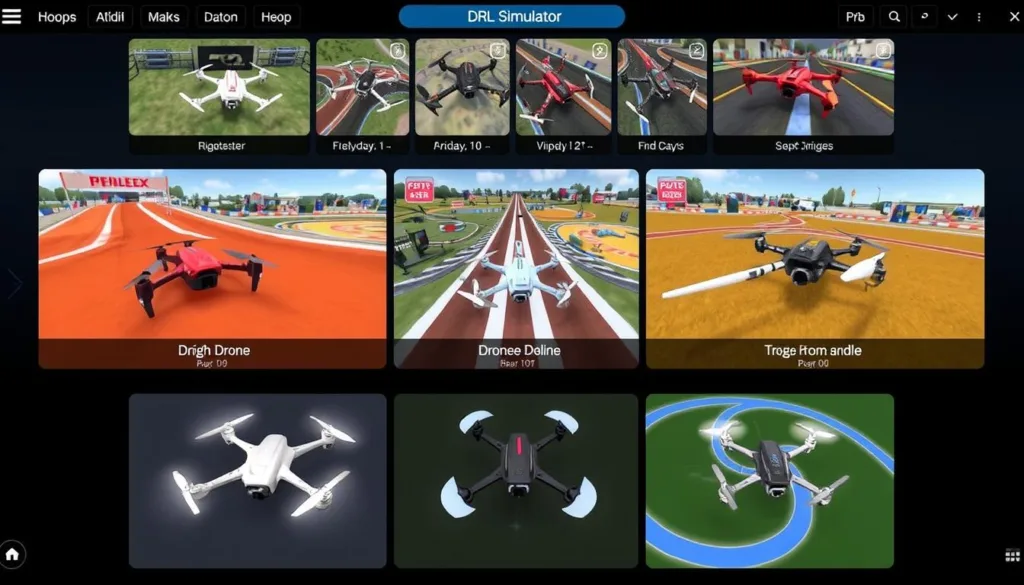
Overview
The DRL Simulator free trial gives users a chance to experience the official Drone Racing League training platform. It’s designed to provide highly accurate physics and professional-grade racing environments, making it an excellent tool for those looking to improve their FPV racing skills.
Features
The trial includes several key features such as 30+ training levels for beginners, multiplayer racing, and a track editor for creating custom courses. It also supports multiple drone types, including FPV, LIDAR, and X-Class, ensuring a comprehensive racing experience.
Pros
The DRL Simulator trial offers realistic physics modeling and handling across different drone classes. It’s an excellent way to develop fundamental skills and get accustomed to the simulator’s interface before deciding to purchase the full version.
Cons
While the trial is comprehensive, it’s time-limited, which means users will eventually need to purchase the full version if they wish to continue using it beyond the trial period.
FPV Freerider Demo
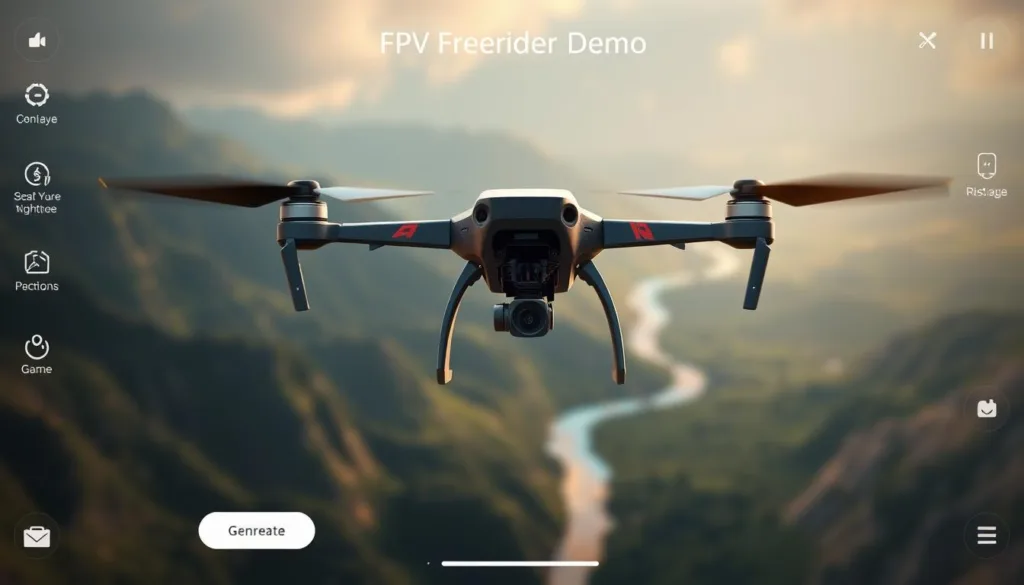
Overview
FPV Freerider is known for its ability to run smoothly on less powerful computers, making it an accessible option for those who want to experience FPV flight without the need for high-end hardware.
Features
The demo version offers a stripped-down but functional experience, prioritizing performance over visual fidelity. This ensures that the simulator remains responsive and provides a realistic flight experience even on older systems.
Pros
One of the key advantages of FPV Freerider is its ability to run on low-end systems, making FPV simulation accessible to a wider audience. It also maintains responsive controls and realistic flight dynamics.
Cons
The demo’s limited features and graphics quality might not appeal to those seeking a more immersive experience. However, for its intended purpose, it serves as an excellent introduction to FPV simulation.
Both the DRL Simulator free trial and FPV Freerider demo offer unique opportunities for FPV enthusiasts to explore premium simulator features without an initial investment. Whether you’re looking to hone your racing skills or simply enjoy casual FPV flight, these free versions can provide a valuable experience.
Best Budget-Friendly Paid Simulators
For those willing to invest in their drone flying experience, several budget-friendly paid FPV simulators offer exceptional value. While free simulators are great for beginners, paid options provide more advanced features, realistic physics, and better graphics.
Velocidrone
Velocidrone stands out as a top choice for competitive FPV drone racing enthusiasts. Its realistic physics engine and accurate recreations of real-world tracks make it a favorite among professional pilots.
Overview
Velocidrone is a premium FPV simulator designed for serious drone racing enthusiasts. It offers a realistic flying experience with accurate physics and authentic tracks.
Features
Some of the key features of Velocidrone include pixel-perfect recreations of real MultiGP tracks, support for various drone sizes (5 inch, micro, and Tiny Whoop), robust multiplayer racing events, and cross-platform support (Windows, Mac, Linux).
Pros
Realistic Physics: Velocidrone’s physics engine is considered one of the most accurate in the industry, providing a realistic flying experience. Extensive Content: The simulator offers a wide range of tracks and drone models, keeping the flying experience fresh and exciting.
Cons
While Velocidrone is highly regarded, it may require a significant investment for additional content packs, and some users might find the initial cost higher than other simulators.
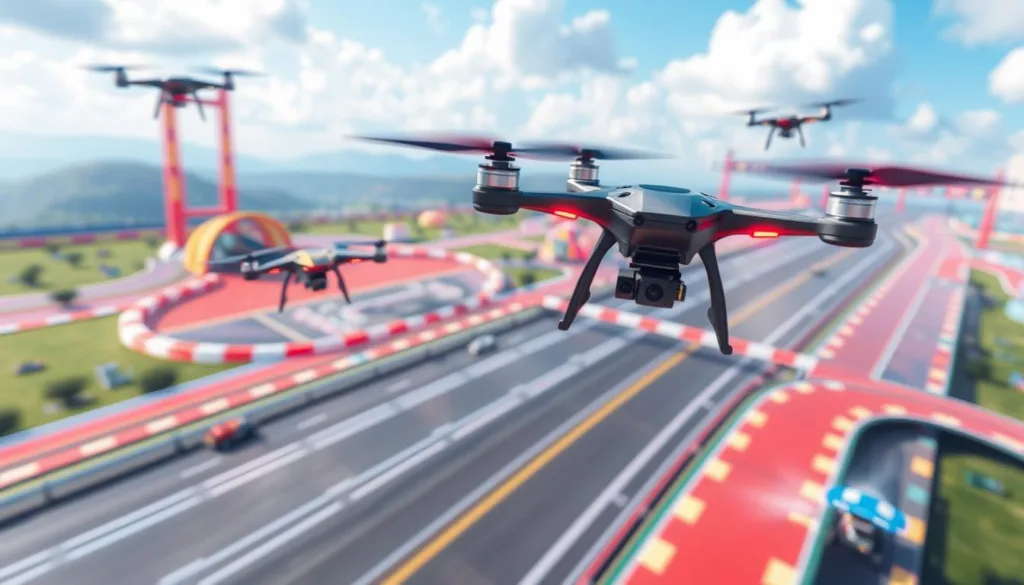
Liftoff
Liftoff is another highly-regarded FPV simulator that excels in both racing and freestyle flying. It offers a diverse range of environments and highly customizable drones, making it a versatile choice for drone enthusiasts.
Overview
Liftoff is a comprehensive FPV simulator available on PC and consoles, offering a realistic flying experience with a variety of modes and environments.
Features
Liftoff’s features include diverse maps, highly customizable drones, and a range of flying modes (racing, freestyle, and more). It’s also available on multiple platforms, ensuring accessibility.
Pros
Versatility: Liftoff offers a great balance between racing and freestyle capabilities, making it suitable for various flying styles. Cross-Platform: The simulator is available on PC and consoles, allowing users to fly on their preferred platform.
Cons
Some users might find that Liftoff’s graphics, while good, don’t quite match the level of other simulators. Additionally, the cost of additional content packs can add up.
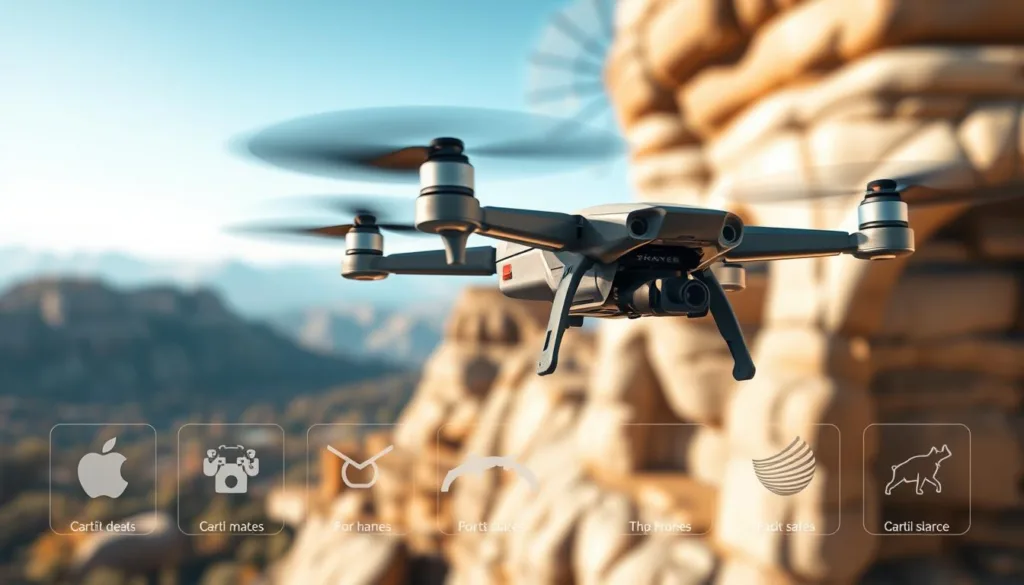
Both Velocidrone and Liftoff offer exceptional value for drone enthusiasts willing to invest in their flying experience. With their advanced features, realistic physics, and diverse content, these simulators represent a logical next step for pilots who have outgrown free options.
Specialized Free FPV Simulators
Beyond general-purpose FPV simulators, specialized options cater to specific niches within the FPV community. These simulators often focus on particular aspects of drone flying, such as realism or freestyle maneuvers.
Real Drone Simulator (RDS)
Real Drone Simulator (RDS) is a free FPV simulator that focuses on extreme realism. It uses actual product specifications and real-life parameters to create highly accurate flight models.
Overview
RDS is designed for pilots seeking a realistic flying experience. It boasts a unique physics calculator that pre-calculates flight characteristics based on specific drone components.
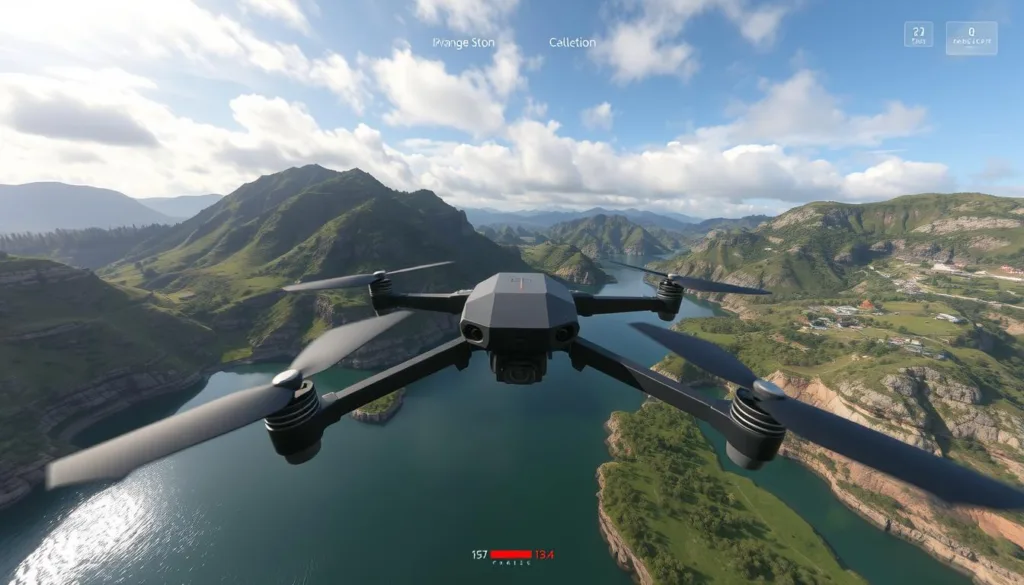
Features
The simulator supports importing blackbox data from real flights to refine its physics model, creating an accurate digital twin of your actual FPV drone. This feature allows pilots to test drone builds virtually before making purchases.
Pros and Cons
Pros: Highly realistic flight models, unique physics calculator. Cons: May lack certain features like racing functionality.
GTA5 FPV Drone Mod
The GTA5 FPV Drone Mod transforms the popular open-world game into a vast playground for virtual drone pilots. It offers unprecedented environmental scale and variety.
Overview
This mod is ideal for pilots looking to practice freestyle flying in detailed urban and rural environments. While not designed as a training tool, it provides a fun and immersive experience.
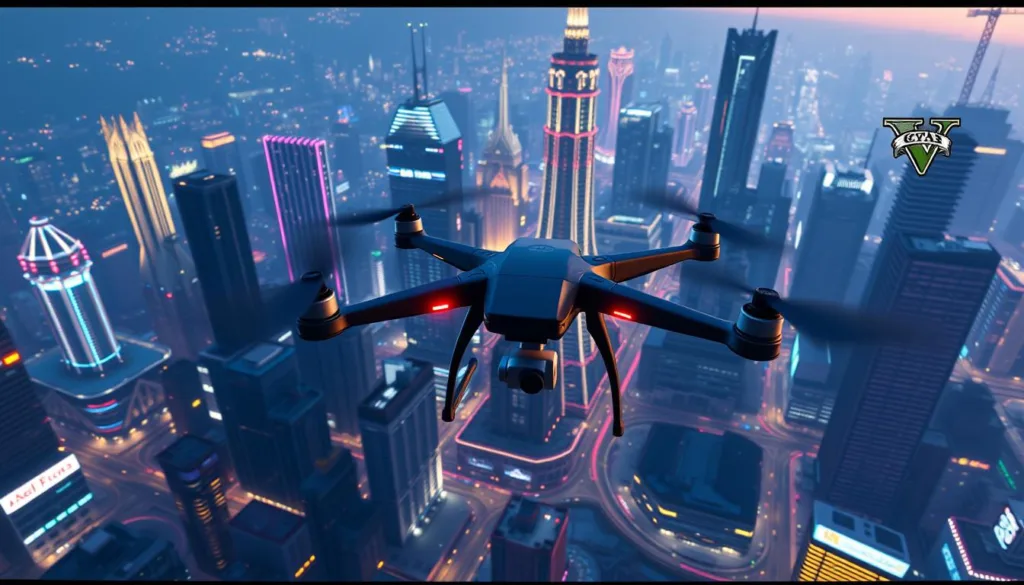
Features
The mod allows for freestyle flying with no limits, providing a unique experience for drone enthusiasts. It leverages the detailed graphics of GTA5 to create a realistic environment.
Pros and Cons
Pros: Unparalleled environmental scale, fun and immersive. Cons: Not specifically designed for training.
These specialized simulators cater to different needs within the FPV community, offering pilots a range of experiences from realistic training to freestyle fun.
Comparing Free vs. Paid Simulators
When choosing an FPV simulator, one of the critical decisions is whether to opt for a free or paid version. Both types have their advantages and cater to different needs of drone pilots.
Physics and Flight Dynamics
Free FPV simulators typically offer good basic physics, allowing beginners to develop fundamental flying skills. However, they may lack the refined flight dynamics found in premium options. Paid simulators invest more in physics development, resulting in more realistic handling that better replicates real-world drone behavior. As “Pretty visuals are great, but not at the expense of smooth, high fps performance”, the best simulators balance visual quality with physics accuracy.
Graphics and Environment Variety
Graphics quality varies significantly between free and paid simulators. While free versions may offer limited environment options, typically 3-5 maps, paid simulators provide dozens of diverse locations for both racing and freestyle practice. Paid options often feature more detailed environments, lighting effects, and drone models, enhancing the overall immersion. However, it’s crucial to note that physics accuracy is more important than graphical quality for effective training.
Community Support and Updates
Community support represents a significant difference between free and paid simulators. Paid options typically offer regular updates, bug fixes, and new content additions. Many paid simulators also feature active online communities that create and share custom tracks, drone models, and training resources. For serious competitors, the additional features and support of paid simulators can be beneficial, while casual users may find free simulators sufficient for developing basic skills.
Getting Started with FPV Simulators: Step-by-Step Guide
Embarking on your FPV simulator journey requires a few straightforward steps to get started. Whether you’re a seasoned drone pilot or a new FPV enthusiast, understanding the basics of simulator setup is crucial.
System Requirements
Before diving into the world of FPV drone simulators, it’s essential to ensure your computer meets the minimum system requirements. Most free FPV simulators are designed to run on modest hardware, including computers with integrated graphics and older processors. Checking the simulator’s compatibility with your operating system is also a crucial step.
Installation Process
The installation process typically involves downloading the simulator from its official website or a platform like Steam. Following the standard installation wizard, you’ll have the simulator up and running in no time. It’s a straightforward process that requires minimal technical knowledge.
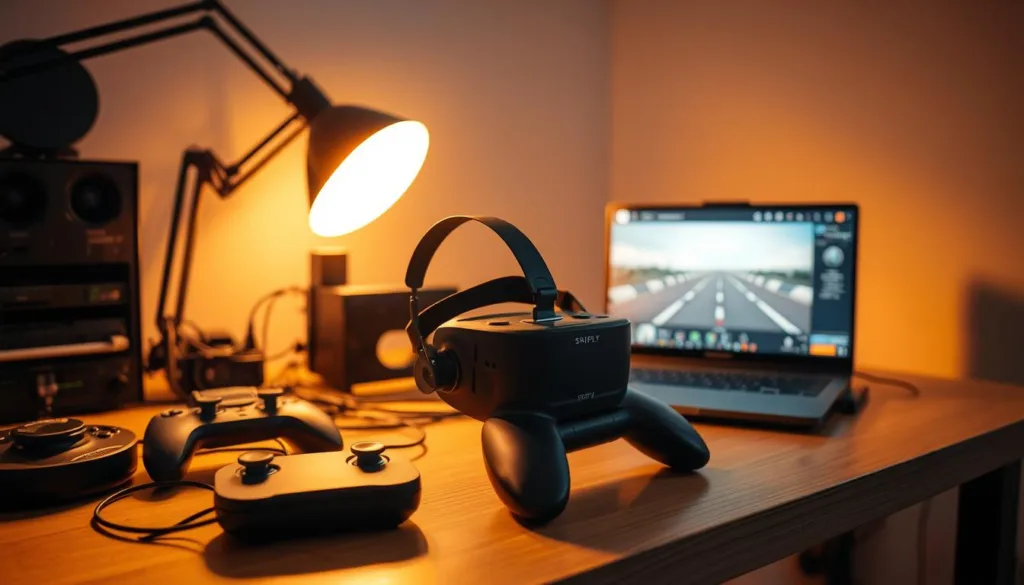
Initial Setup and Configuration
After installation, connecting your radio controller is the next crucial step. Most simulators automatically detect compatible devices, but some may require manual configuration. Initial setup includes calibrating your controller, adjusting rates and expo settings, and selecting appropriate drone models. For a seamless experience, maintaining good posture and positioning your controller similarly to how you would during actual flights helps build transferable muscle memory.
By following these steps and exploring the simulator’s settings, you’ll be well on your way to enjoying the world of FPV drone simulators. Many free versions offer surprising depth of customization, allowing you to tailor your experience to your preferences.
Effective Practice Techniques in FPV Simulators
Effective practice in FPV simulators is key to improving your drone flying skills. To maximize your progress, it’s essential to adopt a structured practice routine rather than flying aimlessly.
Basic Flight Maneuvers
Begin with basic maneuvers like hovering, smooth forward flight, and controlled turns. Practice arming and disarming your drone, landing smoothly by hovering near the ground before disarming, and flying through gaps. These fundamental skills will build your confidence and lay the groundwork for more advanced techniques.
Racing Practice
For racing practice, start by flying clean laps at moderate speeds before pushing for faster times. Focus on consistency before raw speed, and use the simulator’s lap timing features to track your progress and identify areas for improvement.
Freestyle Tricks
When practicing freestyle tricks, break down complex maneuvers into component parts and master each element individually before combining them. Common freestyle maneuvers include rolls, flips, power loops, and split-S turns. Deliberately practice recovering from unusual attitudes and orientations to build reflexive correction skills.
To further enhance your skills, utilize the simulator’s challenge modes or skill games, and record your sessions to identify areas for improvement. By following these effective practice techniques, you’ll be well on your way to becoming a proficient FPV drone pilot.
Transferring Simulator Skills to Real Drones
While FPV simulators are incredibly realistic, the real test lies in applying those skills to actual drone flying. The transition from virtual to real-world flying is not always seamless, but simulator training provides a solid foundation.
Carried Skills
Certain skills developed in FPV simulators directly transfer to real-world flying. Stick movements, muscle memory, and spatial awareness are significantly improved through simulator practice. Pilots also develop mental processes for planning lines, managing speed, and reacting to obstacles, all of which carry over to real environments. Moreover, orientation skills, such as maintaining awareness of the drone’s position and direction, transfer seamlessly from simulator to actual flights.
Skills That Require Adaptation
However, not all skills transfer directly. Simulators cannot fully replicate environmental factors like wind, air density, and propwash effects that impact real-world drone performance. The consequences of mistakes in simulators are also different, as there’s no real-world risk, potentially creating habits that need adjustment when flying actual equipment. Additionally, visual and audio differences between simulators and FPV goggles require some adaptation when transitioning to real-life flying.
Despite these differences, pilots who train extensively in simulators report faster skill development and greater confidence when flying real drones. The key to successful skill transfer is maintaining awareness of these differences and gradually adapting to real-world conditions.
Conclusion: Making the Most of Free FPV Simulators
In the world of drone flying, FPV simulators play a crucial role, and free options are more capable than ever. As we’ve explored, these simulators offer a valuable resource for both beginners and experienced pilots.
Free FPV simulators provide an excellent entry point, allowing pilots to develop fundamental skills without the financial burden. By focusing on their strengths, such as physics accuracy and basic skill development, pilots can extract maximum value from these resources.
Consistent practice with even basic simulators yields significant improvements in real-world flying ability. For many casual pilots, free options provide sufficient functionality, while experienced pilots can use them in conjunction with paid alternatives to enhance their skills.
The key to benefiting from FPV simulators lies in consistent, purposeful practice. Whether you choose free or paid options, the most important factor is using these tools to enhance your real-world flying experience, rather than substituting for it.
FAQ
What is the primary benefit of using an FPV simulator?
The primary benefit is to practice flying without risking damage to your drone, thus saving money on crashes and repairs.
Can FPV simulators help improve my flying skills?
Yes, FPV simulators can help you build muscle memory and improve your flying skills before flying a real drone.
Are FPV simulators compatible with all radio controllers?
Most FPV simulators are compatible with popular radio controllers, but it’s essential to check compatibility before purchasing. You can connect your radio controller via USB.
What features should I look for in an FPV simulator?
Look for simulators with realistic physics, good graphics quality, and customization options to enhance your flying experience.
Can I practice drone racing in FPV simulators?
Yes, many FPV simulators, such as DRL Simulator, offer drone racing modes and tracks to practice your racing skills.
Are there any FPV simulators specifically designed for tiny whoop drones?
Yes, Tiny Whoop GO is a simulator designed specifically for tiny whoop drones, offering a realistic flying experience.
How do I get started with an FPV simulator?
Check the system requirements, follow the installation process, and configure your simulator according to the manufacturer’s instructions.
Can I transfer my simulator skills to real-life drone flying?
Yes, many skills learned in FPV simulators, such as basic flight maneuvers and freestyle tricks, can be transferred to real-life drone flying.

